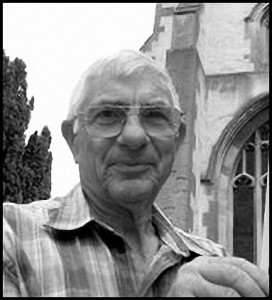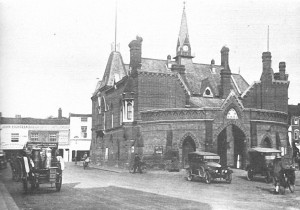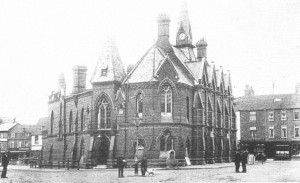 Jim Bell is renowned for the 30 short books he has written on Wokingham. In this article Jim tells the story of how the Wokingham Town Hall was built and a fascinating tale of an old silk weaver from the 1800’s.
Jim Bell is renowned for the 30 short books he has written on Wokingham. In this article Jim tells the story of how the Wokingham Town Hall was built and a fascinating tale of an old silk weaver from the 1800’s.
At a public meeting held in mid-1858 it was resolved to replace the dilapidated 17th century Guild Hall with a new multi-purpose building designed to accommodate a police station, complete with quarters for police officers, plus two cells for prisoners, a courtroom, a savings bank and a reading room for the Literary Society. In the courtyard there would be an exercise yard for prisoners, a covered market and a fire engine. In those days the police were also firemen whose duties were to apprehend arsonists (then known as incendiaries) and fight fires. It was not until 1876 that Wokingham formed its own volunteer firemen. So really the new town hall also accommodated a fire station.
The birth of the Lending Library
Less than five years later the Bank Room itself became dual-purpose when on alternate Saturdays, this room became a Parochial Lending Library organised by the local churches from 11.00 am until 1.00 pm. This continued until 1890 and resumed in 1924 when the County Council was persuaded to provide a public library for Wokingham. Eventually in 1951 the library vacated the town hall and moved to Montague House in Broad Street which the Berkshire Education Committee had purchased for £5,000 for that purpose.
The Competition
The designs of eight architects were considered the winner being Messrs. Poulton and Woodman of Reading. Building would be carried out by Mr. Woodroffe of Reading whose tender was within the limited sum of £3,500. Masonry work would be done by Messrs Wheeler.
The Goodbye Guild Hall Ball
Before demolition commenced a Farewell Ball, organised by the Wokingham Cricket Club was held in the Guild Hall in September of 1858 and it was reported that, the company numbered about ninety of the principal inhabitants of the town with several officers of the 36th Regiment of Aldershot. Dancing was kept up with untiring enjoyment until 4.00 a.m. The excellent music and the sociability of the whole party rendered this final ball a scene to be remembered with satisfaction.
Just avoiding a tragedy
The Guild Hall was duly demolished and construction began at the end of the year. During construction of the new town hall there was only one reported accident which occurred in April 1859 and which involved five labourers. They had just reached the top platform on the inside of the building, each carrying a hod full of bricks, when a portion of the scaffold gave way. Two were comparatively unhurt, but the other three were quite confused and shaken. Two surgeons promptly attended to the sufferers, two of whom were conveyed in a fly to the hospital, but after being attended to were enable to be brought home.
Worker Rewards
Upon completion of construction of the new town hall in November 1859 the inhabitants of Wokingham showed their appreciation of the ‘orderly conduct of the workmen’ by treating them to a supper and evening’s entertainment at the Bush Inn. It was recorded that an excellent repast was served up and a most agreeable evening was spent, the treat being most thoroughly enjoyed by its recipients. They all acknowledged with much feeling their grateful sense of the kindness shown them which they would long remember with pleasure the completion of their part of the building of the Wokingham Town Hall.
Proud of its new Town Hall
The New Town Hall was officially opened on Wednesday, 6th June 1860 amid the usual pomp by the High Steward of the town, Richard Cornwallis Neville, 4th Lord Braybrooke.
The High Steward, attired in military uniform, arrived by rail at about a quarter to one o’clock, and was received by the Alderman, J. L. Roberts, Esq., the members of the Corporation, and a large number of the inhabitants of the town, the band playing the National Anthem, and the bells of the old church ringing out a merry peal.
Who paid for the Town Hall?
Payment for construction and furnishing of the new town hall would comprise a grant of £2,000 by the county to pay for the police quarters, £200 from Wokingham Corporation and the remainder by public subscription. Approximately a hundred and twenty subscriptions were received from the townspeople the largest being £100 from the High Steward.

Town Hall 1920’s The entrance between the two cars leads to the jail which was known as the Dark Hole
‘Sucking the monkey’.
In 1930 local historian Arthur T Heelas (part of the local draper family) wrote a fascinating story about his conversations with some of the old residents from Wokingham, one of which describes the life and times of Chalky, an old silk weaver. In his unpublished memoir ‘A historical sketch of Wokingham’ he writes:
‘Several old inhabitants have told me tales of a well-known local character named Chalky, the last of the silk weavers. Like many of his fellows he liked good ale, not wisely but too well; he used to get very intoxicated and this led to his making the acquaintance of the ‘Dark Hole’, as the dismal lock up under the old Town Hall was called. The only light came from an iron grating about eighteen inches square, through which he could mournfully survey the stocks close at hand, his destination on the morrow following an interview with the bench of magistrates. On one of his frequent visits to the Dark Hole in his usual condition when taken out in the morning, to the surprise of the only constable, he was still in an intoxicated condition. It appears that some jokers during the night went with a funnel and beer, the spout of the funnel was introduced between the iron bars whilst the other end terminated in old Chalky’s mouth’.
Sucking the monkey?
For fluid intake, sailors in the West Indies would drink coconut milk through a straw. Replacing the coconut milk with rum ensured guilty pleasures could take place undetected. Therefore ‘sucking the monkey’ is ‘the surreptitious intake of alcohol taken through a straw’. The ‘monkey’ was used to describe a container of grog.


